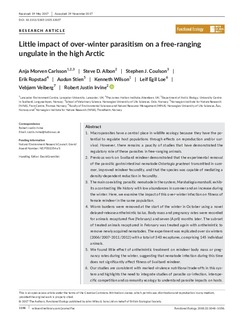| dc.contributor.author | Carlsson, Anja M. | |
| dc.contributor.author | Albon, Steve D. | |
| dc.contributor.author | Coulson, Stephen J. | |
| dc.contributor.author | Ropstad, Erik | |
| dc.contributor.author | Stien, Audun | |
| dc.contributor.author | Wilson, Kenneth | |
| dc.contributor.author | Loe, Leif Egil | |
| dc.contributor.author | Veiberg, Vebjørn | |
| dc.contributor.author | Irvine, Robert Justin | |
| dc.date.accessioned | 2018-04-24T08:18:52Z | |
| dc.date.available | 2018-04-24T08:18:52Z | |
| dc.date.created | 2018-04-19T09:25:05Z | |
| dc.date.issued | 2018 | |
| dc.identifier.issn | 0269-8463 | |
| dc.identifier.uri | http://hdl.handle.net/11250/2495594 | |
| dc.description.abstract | 1. Macroparasites have a central place in wildlife ecology because they have the potential to regulate host populations through effects on reproduction and/or survival. However, there remains a paucity of studies that have demonstrated the regulatory role of these parasites in free-ranging animals. 2. Previous work on Svalbard reindeer demonstrated that the experimental removal of the parasitic gastrointestinal nematode Ostertagia gruehneri transmitted in summer, improved reindeer fecundity, and that the species was capable of mediating a density-dependent reduction in fecundity. 3. The main coexisting parasitic nematode in the system, Marshallagia marshalli, exhibits a contrasting life history with low abundances in summer and an increase during the winter. Here, we examine the impact of this over-winter infection on fitness of female reindeer in the same population. 4. Worm burdens were removed at the start of the winter in October using a novel delayed-release anthelmintic bolus. Body mass and pregnancy rates were recorded for animals recaptured five (February) and seven (April) months later. The sub-set of treated animals recaptured in February was treated again with anthelmintic to remove newly acquired nematodes. The experiment was replicated over six winters (2006/2007-2011/2012) with a total of 343 recaptures, comprising 145 individual animals. 5. We found little effect of anthelmintic treatment on reindeer body mass or pregnancy rates during the winter, suggesting that nematode infection during this time does not significantly affect fitness of Svalbard reindeer. 6. Our studies are consistent with marked virulence nutritional trade-offs in this system and highlights the need to integrate studies of parasite co-infection, interspecific competition and community ecology to understand parasite impacts on hosts. body mass, fecundity, macroparasites, Marshallagia marshalli, Ostertagia gruehneri, reindeer | nb_NO |
| dc.language.iso | eng | nb_NO |
| dc.rights | Navngivelse 4.0 Internasjonal | * |
| dc.rights.uri | http://creativecommons.org/licenses/by/4.0/deed.no | * |
| dc.subject | body mass | nb_NO |
| dc.subject | fecundity | nb_NO |
| dc.subject | macroparasites | nb_NO |
| dc.subject | Marshallagia marshalli | nb_NO |
| dc.subject | Ostertagia gruehneri | nb_NO |
| dc.subject | reindeer | nb_NO |
| dc.title | Little impact of over-winter parasitism on a free-ranging ungulate in the high Arctic | nb_NO |
| dc.type | Journal article | nb_NO |
| dc.type | Peer reviewed | nb_NO |
| dc.description.version | publishedVersion | nb_NO |
| dc.subject.nsi | VDP::Zoologiske og botaniske fag: 480 | nb_NO |
| dc.subject.nsi | VDP::Zoology and botany: 480 | nb_NO |
| dc.source.journal | Functional Ecology | nb_NO |
| dc.identifier.doi | 10.1111/1365-2435.13037 | |
| dc.identifier.cristin | 1580248 | |
| dc.relation.project | Egen institusjon: UNIS | nb_NO |
| dc.relation.project | Andre: Macaulay Development Trust | nb_NO |
| dc.relation.project | Andre: Amundsen Foundation | nb_NO |
| dc.relation.project | Egen institusjon: Norwegian School of Veterinary Science | nb_NO |
| dc.relation.project | Egen institusjon: Norwegian Institute for Nature Research (NINA) | nb_NO |
| cristin.unitcode | 7511,4,0,0 | |
| cristin.unitcode | 7511,2,0,0 | |
| cristin.unitname | Tromsø | |
| cristin.unitname | Avdeling for terrestrisk økologi | |
| cristin.ispublished | true | |
| cristin.fulltext | original | |
| cristin.qualitycode | 2 | |

